University of Wisconsin researchers have made another breakthrough in stem cell research, possibly leading them another step closer to finding a cure for cancers including leukemia.
For the first time, UW researchers successfully reprogrammed bone marrow cells taken from a patient with leukemia back into all-purpose embryonic stem cells, providing a new way to study cancer.
Igor Slukvin, an associate professor of pathology at the UW School of Medicine and Public Health, led the team and said the discovery will likely carry important implications for further research.
“This is important because blood banks have huge amounts of samples of bone marrow,” he said. “You can select as many types of cells as you want and make stem cells out of them.”
Bone marrow cells were converted to all-purpose cells that still carry the mutations that cause leukemia. These findings could provide the foundation for a new research model, a UW release said.
Timothy Kamp, an associate professor of medicine, said Slukvin’s major accomplishment was taking cancer cells and reprogramming them to return to their previous state in order to study leukemia.
Reprogramming a cell is similar to an adult human reversing development and becoming a child again, he said.
The researchers also implemented a lab technique originated by Morgridge Institute researcher James Thomson to eliminate common problems associated with returning cells to the embryonic stage.
“When our organs develop, it’s a one-way street as you go from a precursor stem cell which grows and forms specialized tissues for various systems,” Kamp said. “As these cells grow progressively more specialized, they can’t go back and return to being a stem cell.”
The concept of reprogramming relies on a set of DNA binding proteins that turn on and off gene expression, he said.
Kamp added though human tissues contain nearly 30,000 genes, only a subset are specifically targeted and actually turned on by these proteins.
He said though the concept of reprogramming cells is nothing new, the discovery is important because it is the first time scientists have reprogrammed diseased blood cells.
Previously, healthy skin cells had been used for research. Kamp said the findings mark a major change in the way researchers understand how cells work when affected by certain types of cancer.
With this discovery, scientists will now be able to observe in a laboratory setting as the reprogrammed embryonic stem cells, taken back in time from being cancerous cells, repeat their growth period. In theory, scientists will be able to see diseases develop from scratch, he said.
This is an important step because one of the major focuses of biomedical research is trying to eliminate cancer stem cells at their earliest possible stage.
Although stem cell research has encountered heavy scrutiny by the general public and activists, Slukvin believes that his team’s new findings will not drastically affect public perceptions.
“The stem cell controversy right now deals with embryonic stem cells that are derived from human cells at early stages of gestation, and some people think that’s throwing life away,” he said. “The work we’re doing focuses on donated bone marrow cells.”












